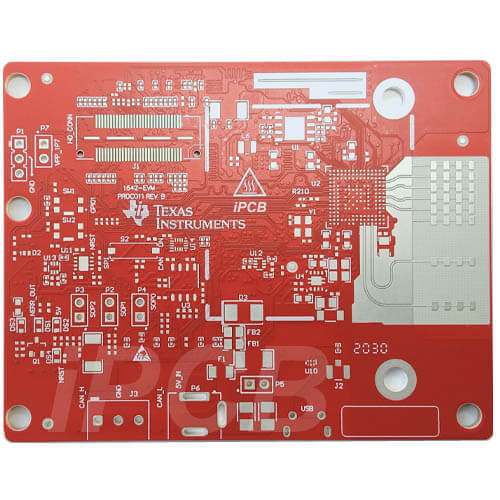Millimeter wave radar sensor has the unique characteristic of all-weather operation in many sensors, which makes it become the key core component in the automotive active safety system (ADAS). The performance of millimeter wave radar sensor is affected by many factors, and PCB circuit material is one of the key factors affecting the performance of sensor circuit. In order to ensure the high stability and performance consistency of millimeter wave sensors, it is necessary to consider many key parameters in PCB circuit materials. This paper discusses several key parameters in PCB circuit materials that affect the stability and consistency of automotive millimeter wave radar sensors, and analyzes how these parameters affect the performance of sensors, so as to better select circuit materials suitable for automotive millimeter wave radar.

With the rapid development of electronic technology, radar PCB technology has also made considerable progress. Radar is developed for military purposes. In the era of peace and development, radar technology is increasingly transferred to civilian use. For example, the speed detection radar commonly used in traffic in our country, the car collision avoidance radar that is developing rapidly, etc. With the continuous reduction of the cost, radar will be used more and more widely in civil areas. Compared with laser ranging, radar ranging is not limited by climatic conditions, with long distance and high accuracy. The specific uses and structures of various radars are different, but the basic forms are the same, including transmitter, transmitting antenna, receiver, receiving antenna, processing part and display. There are power supply equipment, data acquisition equipment, anti-interference equipment and other auxiliary equipment. The advantage of radar is that it can detect distant targets in the day and night, and is not blocked by fog, clouds and rain. It has the characteristics of all-weather and all-weather, and has a certain penetration ability. Therefore, it has not only become an indispensable electronic equipment in military affairs, but also widely used in social and economic development (such as weather forecasting, resource detection, environmental monitoring, etc.) and scientific research (celestial body research, atmospheric physics, ionospheric structure research, etc.). Spaceborne and airborne synthetic aperture radars have become very important sensors in remote sensing. Radar targeting the ground can detect the precise shape of the ground. Its spatial resolution can reach several meters to tens of meters, and is independent of distance. Radar has also shown good application potential in flood monitoring, sea ice monitoring, soil moisture survey, forest resource inventory, geological survey, etc.
The linearity of radar waveform is similar to other radar technologies. The automobile radar also relies on receiving the reflected signal from the target object, and further analyzes the multiple correlation between the received signal and the original transmission signal in time, frequency and phase, so as to judge the relative speed and space position between the target object and the radar. One of the core technologies of automotive radar is radar waveform design. Linear frequency modulated continuous wave (LFMCW, often referred to as FMCW) is a common radar waveform. The stability and linearity of the transmitted signal (i.e. waveform) directly affect the radar's ability to identify the target object. Since most automotive radars work in the millimeter wave band, the inherent nonlinear characteristics of various materials and components selected will be incorporated into the final transmission signal and reception signal, thus jamming signal analysis algorithm. The automobile radar uses the frequency difference and phase difference between the transmitted signal and the received signal to judge the speed and position of multiple target objects. When the linearity of the whole radar system, especially the transmitter part, is not ideal, the calculation results of frequency difference and phase difference will be ambiguous, causing the radar system to be unable to correctly judge the target object, resulting in major errors. For the future automatic driving control technology, this is absolutely to be avoided. In order to minimize the error rate, the linearity of the transmitted signal must be improved as much as possible, and the stability of the linearity of the product must be ensured by measurement. Based on the strict requirements of signal quality, high-end instruments and equipment are mostly used for linearity measurement to reduce measurement error. Current high-end instruments can analyze signals with bandwidth exceeding 1-GHz to ensure complete measurement of radar signals.
Automobile millimeter wave radar is rapidly expanding to provide more driving aids and higher safety for vehicles. Antenna design and measurement In the application of automotive radar, phased array is usually used for both transmitting antenna and receiving antenna. According to the overall design needs, linear array or planar array can be used. As we all know, the main parameters of array antenna (such as main lobe direction and width, side lobe suppression, zero point position, etc.) can be calculated by simple mathematical formulas. However, the applicability of this calculation result is conditional, that is, when the mutual coupling effect and influence between any two elements in the array are so small that they can be ignored. One way to meet the above conditions is to increase the relative distance between array elements. However, the impact of this method is that the size of the end product will also increase. If the purpose of effectively and accurately designing array elements cannot be achieved by calculation, measurement will become an important means in the optimization process, and the corresponding computer software will be used as an aid to facilitate big data calculation. The optimization of array antenna is generally divided into the following steps:
1) Design of radiation field pattern for basic elements of array
2) Evaluation of mutual coupling between array elements
3) Design of radiation field pattern of antenna array
4) Design of array feeding system
5) Integrated Design of Millimeter Wave Radar Transceiver System
6) Consideration of the impact of vehicle bumpers